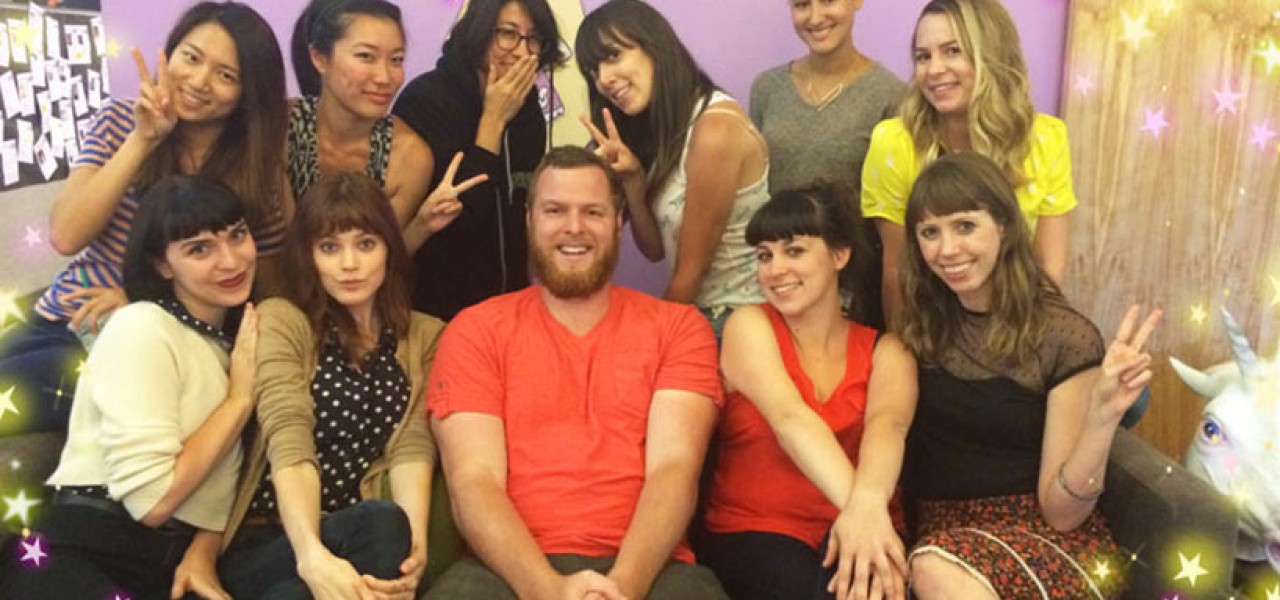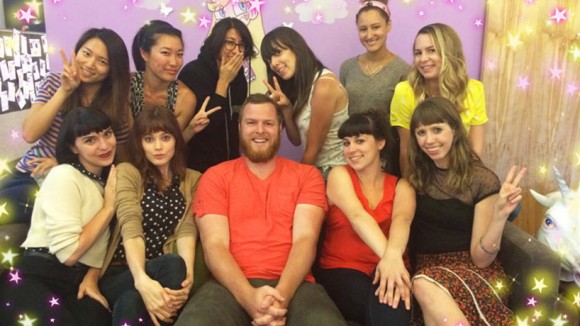

Crashing the Boy’s Club: Women Speak Out About Gender Inequality in Animation
On Friday, Buzzfeed published one of the more important pieces of animation journalism that you’re going to read this year — or any year for that matter: “Inside The Persistent Boys Club Of Animation.”
The no-holds-barred 4,800-word piece written by Ariane Lange sheds unprecedented light on the challenges faced by women who work in the animation industry, from outright sexual harassment to more subtle forms of discrimination that prevent women from receiving the same kind of advancement opportunities afforded to male counterparts. The strength of Lange’s piece comes from its thoroughness; she spoke to a good sample of industry artists, representing a diverse array of professionals from the last five decades, working throughout TV and feature animation.
With the exception of Glen Keane, few institutions or individuals come across well in the piece. Here’s recent CalArts grad Sabrina Cotugno speaking about her experience at the lauded animation school:
According to Cotugno, CalArts subtly encourages men in story and women in design. Her classes were generally gender-balanced, yet it was “primarily guys who would get known for being great storytellers,” she said over Skype. Female students would be rewarded for color or graphic choices, which Cotugno termed “the pretty part.” “Many women would start out thinking they wanted to storyboard and decide against it, saying, ‘I can’t really articulate why but I just don’t feel good about it.’” It happened to Cotugno: She abandoned storyboarding after feeling alienated by the aggressively masculine behavior she encountered. In an email, Cotugno said the actual incidents were subtle. “It would be so easy for guys to say, ‘You’re exaggerating,’ or ‘You’re overreacting, that was nothing,’” she explained. It was only after college that Cotugno fell back into storyboarding professionally — and realized that it wasn’t storyboarding she didn’t like, it was story bros. Even now, working on a show with people she likes and, she noted, a male showrunner who took a chance on her despite her inexperience, it sometimes gets uncomfortable to be outnumbered. “I’m always the one like, Oh, here’s the queer feminist, gotta say her social issues again.”
Legendary animation director Ralph Bakshi doesn’t do well either, thanks to two former employees who speak openly about the 76-year-old artist:
[W]hen [Joanna] Romersa was working at the studio of animation pioneer Ralph Bakshi as a secretary and production manager in the ’70s, she “used to think Ralph was mad at me if he didn’t pat my butt or pinch my boob. … Bakshi was a bastard.” A second artist who worked at Bakshi’s studio in the ’70s and ’80s did not remember him physically touching his female employees, but did say he frequently made remarks to her “that would be considered sexual harassment now.” The former employee, who asked to remain anonymous, said Bakshi would offer to have sex with her in his office, and when she would decline, he would laugh it off as if it were a joke. “It made you wonder who actually did take him up,” she said, adding that whenever a woman got a promotion or a desirable credit on a project, other artists would assume that woman had performed sexual favors for Bakshi…Still, she said she was grateful for the opportunity: Bakshi was one of the few studio heads who would hire women at all.
Multiple artists also chide Pixar, including former story artist Emma Coats, who reveals she left the studio over the studio’s poor treatment of Brave director Brenda Chapman, a story that Cartoon Brew exclusively broke in 2010:
Ziah Fogel, who specialized in crowds animation at Pixar, said the studio is “very clique-y in general.” She described herself as “a bit aggressive for a female” and said she fit in with her mostly male co-workers because of that. She felt she got preferential treatment because of her ability to fit in to “the drinking culture” and hold forth on whiskey. Other women, she said, could be put off by the “culture of bros.” And if you are put off by it, you might not advance, or you might give up on narrative animation like [Emma] Coats did.
Coats left Pixar — and animation for the most part — mainly because of what happened to [Brave director Brenda] Chapman. “When she was removed from her project, I felt kind of lost,” she said. Because there were no other women directors to look up to, Coats couldn’t tell if the way Chapman was treated was an anomaly or part of a pattern (although hiring exclusively male directors is itself a pattern). “I can’t see why what happened to her wouldn’t happen to me,” Coats said.
None of the individuals or institutions criticized in the piece responded to Buzzfeed’s request for comment. But female industry artists who have read the piece have praised it on Twitter as being reflective of their own experiences:
This is so disheartening. I've gone through many of these experiences and am genuinely shocked to say I still do. http://t.co/G1rBkgYxEn
— Lauren Faust (@Fyre_flye) August 30, 2015
Damn, this article hits close to home: http://t.co/ERN8302jji Thanks, @BuzzFeed for great journalism on women in animation.
— Sarah Marino (@sarahmarino) August 28, 2015
A very truthful article on the treatment of women in the animation industry, definitely worth a read http://t.co/TKFChLGu1k
— katie mitroff (@katiemitroff) August 29, 2015
Among the few criticisms of the piece was offered by Lissa Treiman, a story artist at Disney Feature Animation who wrote in a series of tweets that gender inequality is being addressed at Disney Feature Animation:
While it certainly highlights some areas where progress badly needs to be made, i feel like it ignores places where progress is happening…
— Lissa Treiman (@lbtreiman) August 28, 2015
If you count our directors, our story department at Disney Feature includes 10 women!
— Lissa Treiman (@lbtreiman) August 28, 2015
While still less than 1/3 of the department as a whole, in the 8 years that i've been here i've been watching that number steadily grow
— Lissa Treiman (@lbtreiman) August 28, 2015
Yes, there is certainly a boys club history in this industry, and it's not totally gone. But the landscape is noticeably changing
— Lissa Treiman (@lbtreiman) August 28, 2015
Maybe i feel like the article is saying "Girls are being scared out of story" while i'm actually seeing more & more punch their way in here!
— Lissa Treiman (@lbtreiman) August 28, 2015
While Treiman debates the perspective of the article — is the glass half-full or half-empty? — she doesn’t question its accuracy. That’s because the type of stories in this piece are familiar to everyone involved in the animation industry.
The remarkable thing, though, is that the media is finally paying attention. Last May, the LA Times published a piece on the surge of female enrollment in animation programs, a trend that has been gaining traction for well over a decade now. That piece was of the glass half-full variety, a bit of carefully calculated PR puffery that ignored the realities of the industry, with prominent male industry figures making tone-deaf assertions, such as attributing the uptick in female enrollment at animation schools to films like Brave and Frozen.
The Buzzfeed piece, on the other hand, is a harsher but more realistic view of the historically male-dominated animation industry, revealing the true inequity of the situation. Even today, when women outnumber men at many major animation schools, the pathways to the top of the industry remain a greater challenge for women than men owing to deeply ingrained institutional biases that exist at all the major studios.
We could perhaps criticize the Buzzfeed piece for being incomplete — interviews with eight or so industry artists don’t represent the thousands of viewpoints possible — yet we can also praise it as a step in the right direction. The piece is starting a discussion. For years, no one dared to address gender bias, conscious or not, in the industry — and the media was completely oblivious to the idea that it wasn’t an even playing field for all animation artists.
For example, in 2012, when Cartoon Network had greenlit an animated series by Rebecca Sugar, no media organization or fan coverage recognized that Cartoon Network had never had a solo female creator in the network’s twenty-year history. It was only one month after the announcement of Steven Universe, when I wrote about how it was an ignominious Cartoon Network first that other media organizations picked up on it — first, The Mary Sue and soon everybody else. The mainstream media began writing pieces about Sugar’s trailblazing achievement without questioning the systemic inequality that allowed Cartoon Network to create 20 years of programming without acknowledging the voices of women creators.
The Buzzfeed article is another sign of broad shifts in the industry. Animation is maturing. It is becoming more inclusive as an industry. With a greater variety of stories being told, it is also becoming more interesting as an art form. Equally important, artists are no longer afraid to speak openly about their experiences and point out unfairness when they see it. These are positive and necessary steps toward making animation a healthier and more vibrant industry.
Next month, at Festival by Pixelatl in Mexico, I will be moderating a Women in the Animation Industry panel that will include artists from Mexico, the United States, and Europe. This discussion is, after all, just beginning.
(Top photo: The creative staff of Disney TV Animation’s “Star vs. the Forces of Evil” shows the bigger role that women play in today’s animation industry.)
